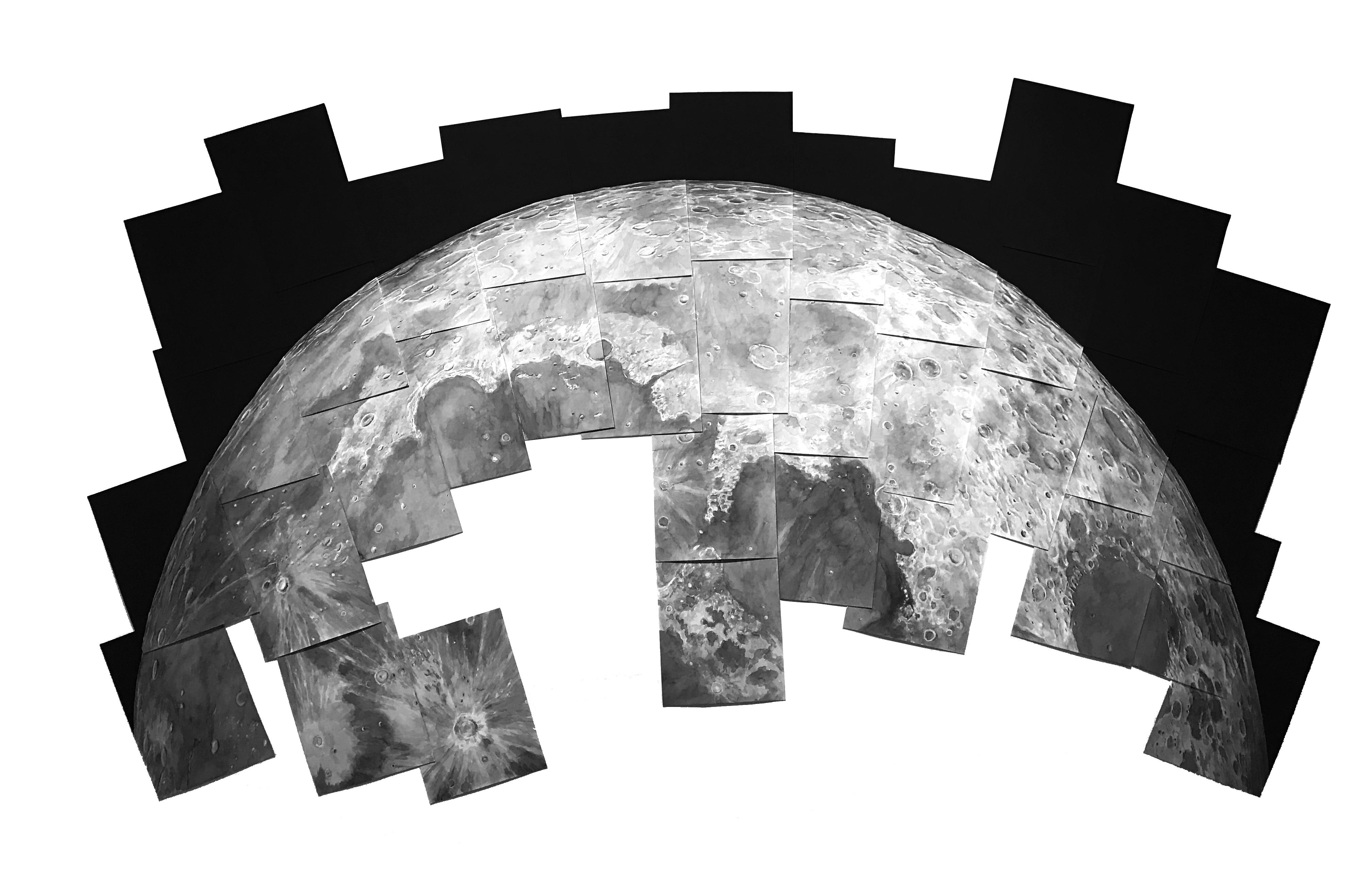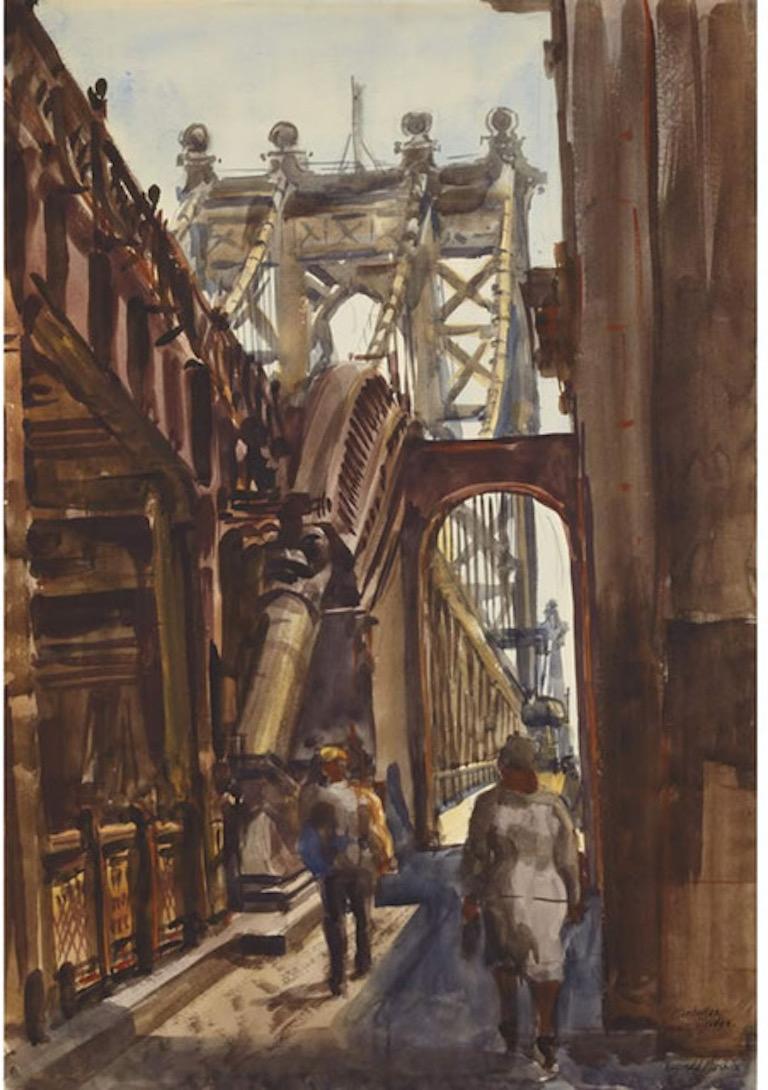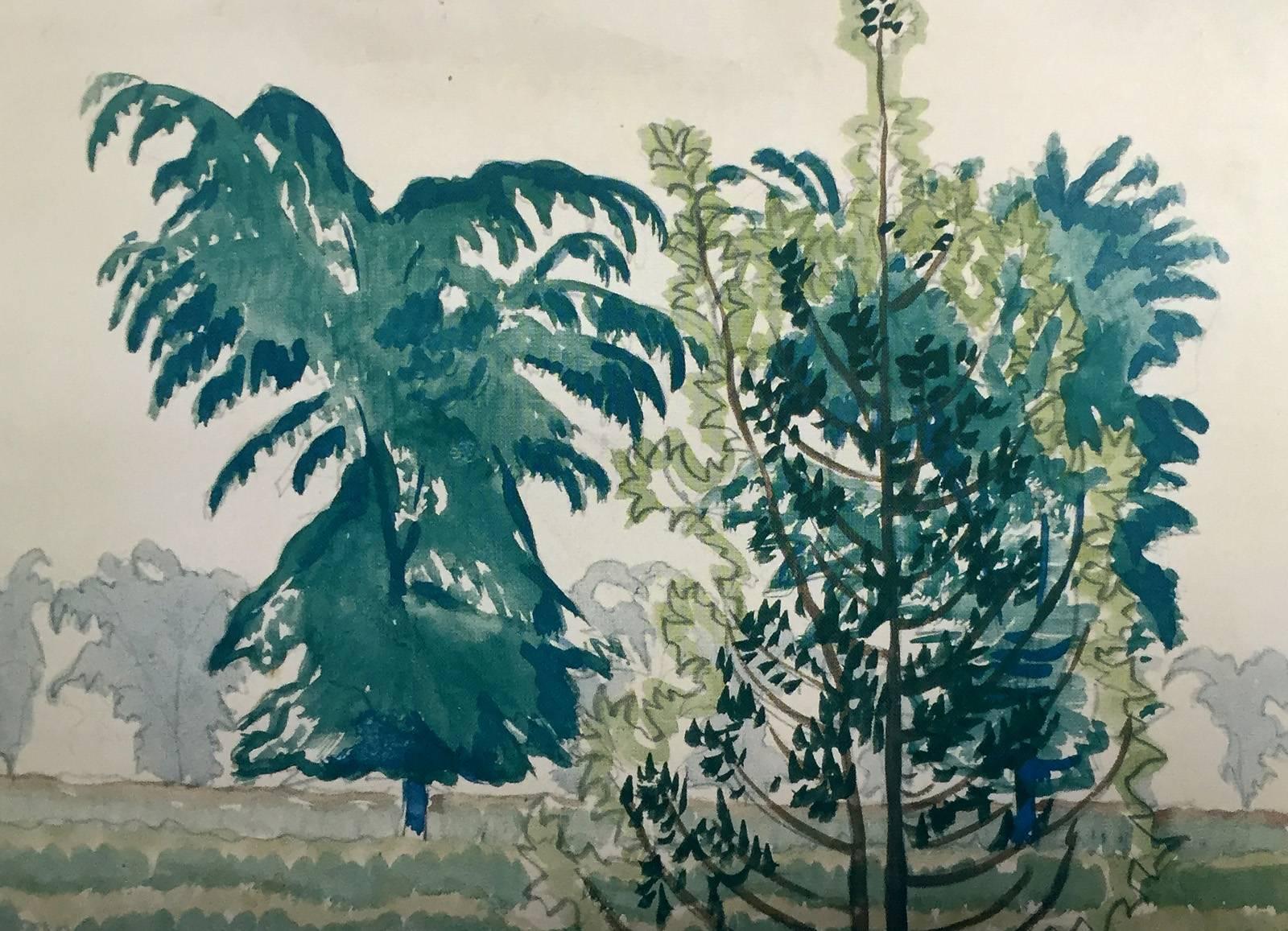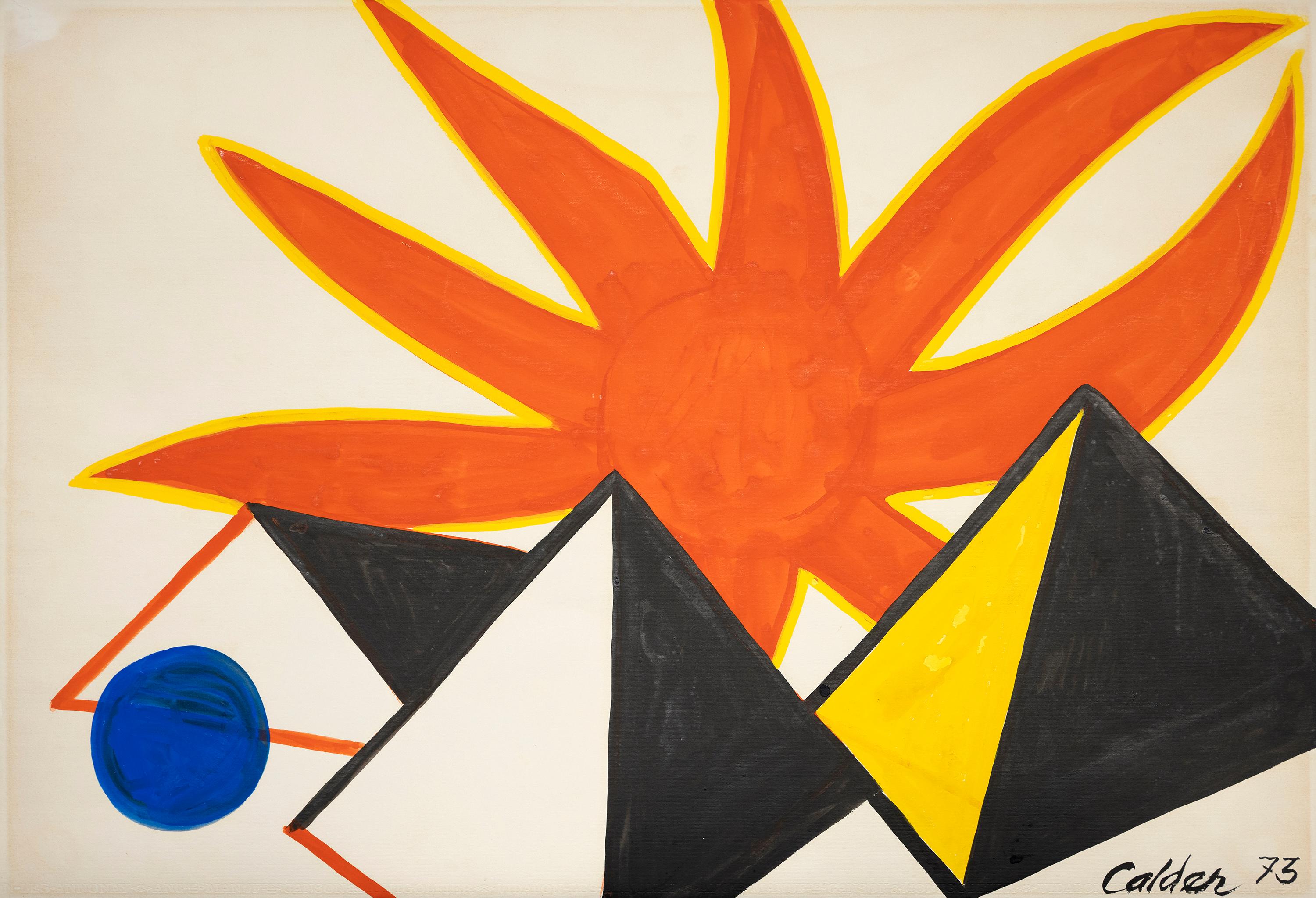Items Similar to "Song of Songs Illustration" Watercolor, Old Testament Story, Colors
Want more images or videos?
Request additional images or videos from the seller
1 of 6
Ze'ev Raban"Song of Songs Illustration" Watercolor, Old Testament Story, Colors
About the Item
SALE ONE WEEK ONLY
"Song of Songs Watercolor" renders an important bibilical story that is celebrated during Jewish Passover. Song of Solomon, also called Canticle of Canticles, or Song of Songs, an Old Testament book that belongs to the third section of the biblical canon, known as the Ketuvim, or “Writings.” In the Hebrew Bible the Song of Solomon stands with Ruth, Lamentations, Ecclesiastes, and Esther and with them makes up the Megillot, five scrolls that are read on various religious festivals of the Jewish year. This book is the festal scroll for Pesaḥ (Passover), which celebrates the Exodus of the Israelites from Egypt.
This work has a provenance with Sotheby's.
Raban easily navigated a wealth of artistic sources and mediums, borrowing and combining ideas from East and West, fine arts and crafts from past and present. His works blended European neoclassicism, Symbolist art and Art Nouveau with oriental forms and techniques to form a distinctive visual lexicon. Versatile and productive, he lent this unique style to most artistic mediums, including the fine arts, illustration, sculpture, repousee, jewelry design, and ceramics.
He is regarded as a leading member of the Bezalel school art style, in which artists portrayed both Biblical and Zionist themes in a style influenced by the European Jugendstil (similar to Art Nouveau) and by traditional Persian and Syrian styles.
Like other European art nouveau artists of the period, such as Alphonse Mucha, Raban combined commercial commissions with uncommissioned paintings.
Good examples of Raban's specific eclectic mix of European and Oriental styles are his illustrated editions of the Book of Ruth, Song of Songs, Book of Job, Book of Esther, and the Passover Hagadah. Known are also his playing cards, where in the suit of leaves, the King is Ahasuerus, the Queen is Esther, and the Jack is Haman.
Unframed the piece is 4.38" h x 3.25" w
- Creator:Ze'ev Raban (1890 - 1970)
- Dimensions:Height: 9.25 in (23.5 cm)Width: 7.75 in (19.69 cm)
- Medium:
- Period:
- Condition:
- Gallery Location:Detroit, MI
- Reference Number:1stDibs: LU128617031902
About the Seller
5.0
Vetted Seller
These experienced sellers undergo a comprehensive evaluation by our team of in-house experts.
Established in 2014
1stDibs seller since 2019
96 sales on 1stDibs
Typical response time: 4 hours
- ShippingRetrieving quote...Ships From: Detroit, MI
- Return PolicyA return for this item may be initiated within 14 days of delivery.
More From This SellerView All
- "Untitled (Dock Scene)" Watercolor on Paper, Local Scene, Buildings, WaterLocated in Detroit, MIThe idyllic atmosphere of this local dock scene falls within a couple of styles one being regionalism, an American realist modern art movement that included paintings, murals, lithographs, and illustrations depicting scenes of rural and small-town America primarily in the Midwest and frequently associated with Grant Wood and Thomas Hart Benton. The other style is romanticism wherein the scene depicted is a more desired or dramatic version of what actually is. “Untitled (Dock Scene)” is typical of a small town dock scene from Michigan where Culver lived or from places as far away as Maine, but what makes it important is its easy familiarity: water, gulls or terns, slanting wood shanties, scruffy dirt patches and course grasses. It is not idealized, but does set the tone of fresh air, the scream of birds and the sun on water. This piece has been professionally reframed with acid-free matting and museum glass. In a 1952 Detroit Free Press article, entitled “Artist Explains His Work,” Culver was asked why he painted the way he did. He stated: “I try to ‘see’ though not too exactly; I try to think though not too ponderously; I feel emotion yet I try not to become overwrought. I interpret rather than describe, and design rather than depict. I work with values, not light and shade; hence, when I am successful, I achieve substance rather than three-dimensional form, and this satisfies me as being wholly sufficient. In my work I wish to be serious without becoming a bore, exuberant without being frivolous, humorous without being silly. I believe that good paintings are conceived, not contrived; and I am interested in art much more than in pictures.” Charles Culver...Category
1940s Naturalistic Landscape Drawings and Watercolors
MaterialsWatercolor, Paper
- Charles Culver Landscape "Late Afternoon Landscape" Watercolor on PaperLocated in Detroit, MI“Late Afternoon Landscape” is set in the golden light of evening painted in the mid-west town of Utica, Michigan. It has the atmosphere of when work is done and peace and quiet blanket the countryside. The The farm machinery has ceased its racket as has the family dog wandering about for one last sniff. This piece has been professionally reframed with acid-free matting and conservative glass. In a 1952 Detroit Free Press article, entitled “Artist Explains His Work,” Culver was asked why he painted the way he did. He stated: “I try to ‘see’ though not too exactly; I try to think though not too ponderously; I feel emotion yet I try not to become overwrought. I interpret rather than describe, and design rather than depict. I work with values, not light and shade; hence, when I am successful, I achieve substance rather than three-dimensional form, and this satisfies me as being wholly sufficient. In my work I wish to be serious without becoming a bore, exuberant without being frivolous, humorous without being silly. I believe that good paintings are conceived, not contrived; and I am interested in art much more than in pictures.” Charles Culver...Category
1940s Naturalistic Landscape Drawings and Watercolors
MaterialsWatercolor, Paper
- Charles Culver Watercolor Landscape "Red Hills Near Patzcurao" Signed & DatedLocated in Detroit, MIThe idyllic atmosphere of this Mexican scene is located in Mexico, west of Mexico City and south of Guadalajara. “Red Hills Near Patzcuaro” is set in a golden light. and was one of three paintings by the artist while the artist visited Patzcuaro, Mexico. The humans depicted lend an atmosphere to the painting and an indication of location - dressed in native Mexican peasant dress - without being obtrusive and causing the viewer to concentrate on them. The intense red hills of Patzcuaro are the feature in this painting along with the pinon and juniper trees and the Chamisa shrub. This piece has been professionally reframed with acid-free matting and museum glass. In a 1952 Detroit Free Press article, entitled “Artist Explains His Work,” Culver was asked why he painted the way he did. He stated: “I try to ‘see’ though not too exactly; I try to think though not too ponderously; I feel emotion yet I try not to become overwrought. I interpret rather than describe, and design rather than depict. I work with values, not light and shade; hence, when I am successful, I achieve substance rather than three-dimensional form, and this satisfies me as being wholly sufficient. In my work I wish to be serious without becoming a bore, exuberant without being frivolous, humorous without being silly. I believe that good paintings are conceived, not contrived; and I am interested in art much more than in pictures.” Charles Culver...Category
1940s Naturalistic Landscape Drawings and Watercolors
MaterialsWatercolor, Paper
- Charles Culver Landscape Winter Road Watercolor Signed & DatedLocated in Detroit, MIThe idyllic atmosphere of this country scene falls within a couple of styles one being regionalism, an American realist modern art movement that included paintings, murals, lithographs, and illustrations depicting scenes of rural and small-town America primarily in the Midwest and frequently associated with Grant Wood and Thomas Hart Benton. The other style is romanticism wherein the scene depicted is a more desired or dramatic version of what actually is. “Untitled (Winter Road)” is a quiet country scene depicting a road leading into the distance either going to or coming from a local farm. The snow does not particularly seem fresh suggesting a melt and the coming of spring. This piece has been professionally reframed with acid-free matting and conservator glass. In a 1952 Detroit Free Press article, entitled “Artist Explains His Work,” Culver was asked why he painted the way he did. He stated: “I try to ‘see’ though not too exactly; I try to think though not too ponderously; I feel emotion yet I try not to become overwrought. I interpret rather than describe, and design rather than depict. I work with values, not light and shade; hence, when I am successful, I achieve substance rather than three-dimensional form, and this satisfies me as being wholly sufficient. In my work I wish to be serious without becoming a bore, exuberant without being frivolous, humorous without being silly. I believe that good paintings are conceived, not contrived; and I am interested in art much more than in pictures.” Charles...Category
1940s Naturalistic Landscape Drawings and Watercolors
MaterialsWatercolor, Paper
- "Mexicantown: Bagley Bridge" Proposal Drawing for Tile Mosaic, WatercolorBy Hubert MasseyLocated in Detroit, MI"Mexicantown: Bagley Bridge" is a proposal drawing for a mural completed by Hubert Massey in 2016. It is colorfully rendered on paper with color pencil a...Category
2010s Contemporary Drawings and Watercolor Paintings
MaterialsColor Pencil, Watercolor, Paper
- "McDonald's Hamburgers Invading Japan/Self-Portrait", Watercolor, FigurativeBy Masami TeraokaLocated in Detroit, MI"McDonald's Hamburgers Invading Japan" is a delightfully inventive comic self-portrait by the creative genius Masami Teraoka. He has presented himself dressed in the traditional kimono robe and the artwork is in the famous Ukiyo-e style. Ukiyo-e is a genre of Japanese art which flourished from the 17th through 19th centuries. Its artists produced woodblock prints and paintings of such subjects as female beauties; kabuki actors and sumo wrestlers; scenes from history and folk tales; travel scenes and landscapes; flora and fauna; and erotica and sometimes humorous characters. The term ukiyo-e (浮世絵) translates as "picture[s] of the floating world". This delightful watercolor self-portrait, comments on the problematic relationship between the United States and Japan and the Americanization of his country in the work, utilizing subtle pun humor that is the hallmark of Japanese culture. As Teraoka explains, "the character 'maku; means spread, 'donald; means screaming, 'do' and 'han' mean often, and 'Han' also means obnoxious or annoying. 'Burger' sounds like 'Baka' which means stupidity." This work was originally purchased by filmmaker Eric Saarinen...Category
Late 20th Century Contemporary Figurative Drawings and Watercolors
MaterialsWatercolor, Paper
You May Also Like
- "Andromeda" Large Scale Watercolor Galaxy painting by Thomas BroadbentBy Thomas BroadbentLocated in New York, NYAt over 11 feet in length, Broadbent’s “Andromeda” galaxy watercolor painting captures the spectacle and wonder one feels when looking at the stars in the night sky. In this large sc...Category
2010s Contemporary Landscape Paintings
MaterialsWatercolor, Archival Paper
- "Moon Arc", Multi-panel black and white watercolor painting installationBy Thomas BroadbentLocated in New York, NY87"x149" multi-panel installation. This watercolor painting installation is created on 36 paper panels and is inspired by a view of the moon. The dee...Category
2010s Contemporary Landscape Drawings and Watercolors
MaterialsWatercolor, Archival Paper
- Watercolor and Gouache on Paper, by Charles Burchfield, circa 1925Located in New York, NYCharles Burchfield, 1893-1967 Wallpaper Design No.2, 1922-28 Watercolor and gouache on paperCategory
1920s Landscape Drawings and Watercolors
MaterialsPaper, Watercolor, Gouache
- "Manhattan Bridge" NYC American Scene Modernism Watercolor WPA Urban RealismBy Reginald MarshLocated in New York, NYReginald Marsh "Manhattan Bridge" NYC American Scene Modernism Watercolor WPA Urban Realism, 20 x 14 inches. Watercolor and pencil on paper, 1938. Signed...Category
1930s American Modern Landscape Drawings and Watercolors
MaterialsPaper, Watercolor, Pencil
- Untitled (Trees)By Charles E. BurchfieldLocated in Buffalo, NYAn original watercolor on paper by American modernist Charles E. Burchfield, created in 1916. This work comes in an archival frame presentation and has been authenticated by the Bur...Category
1910s American Modern Landscape Drawings and Watercolors
MaterialsWatercolor, Paper
- Three Pyramids + Blue BallBy Alexander CalderLocated in Palm Desert, CA"Three Pyramids + Blue Ball" is a gouache on paper by Alexander Calder. The work is signed in the lower right, "Calder 73”. Although renowned for his innovative and groundbreaking sculptures, Alexander Calder started his artistic career as an abstract painter, preferring to use gouache. What is gouache? Gouache is a water-soluble paint – a type of opaque watercolor. As Calder returned to gouache painting towards the end of his life, he was now armed with a lifetime of experience as a sculptor. He explored the three-dimensional vocabulary of sculptural forms he had developed onto the two-dimensional surface of the paper. Certain shapes and colors recur throughout his gouaches and sculptures. Circles, ovals, and other geometric forms dominate the space. There is the same sense of energy and fluidity. The shapes do not sit on the surface but vibrate giving a feeling of movement in contrast to the static nature of painting. Like his sculpture, Calder’s gouache...Category
1970s Abstract Abstract Drawings and Watercolors
MaterialsPaper, Ink, Gouache
Recently Viewed
View AllMore Ways To Browse
Other Stories
Vintage Story
Song Of Songs
The Song Of Songs
Old Testament
Vintage Illustration Style
Vintage Landscape Illustration
Vintage Old Book
Old Testament Art
Vintage Story Book
Retro Landscape Illustration
Old Egypt
Old Old Bibles
Vintage Jewelry Drawing
Old Bible
Old Testament Paintings
Biblical Drawings
Book Of Job





